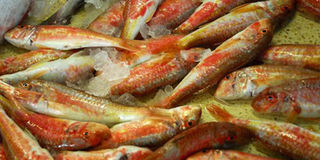Adopt ornamental fish for more income, smallholder farmers told

Ornamental fish displayed. An initiative to popularise ornamental fish rearing among smallholder farmers across the African continent is underway. PHOTO | FILE | NATION MEDIA GROUP
What you need to know:
- Ornamental fish farming is doable in all the 54 African states, and can be a source of employment and foreign exchange earner.
- The industry is primarily in the hands of middlemen who take advantage of the smallholder farmer.
- It is possible to collect the fish from the wild but the farmer should first obtain permit from the State Department of Fisheries for exploitation from the wild.
An initiative to popularise ornamental fish rearing among smallholder farmers across the African continent is underway.
Fisheries experts from the Inter-African Bureau for Animal Resources (AU-AIBAR), a specialised technical office of the Department of Rural Economy and Agriculture (DREA) of the African Union Commission (AUC), believe that ornamental fish farming is doable in all the 54 African states, and can be a source of employment and foreign exchange earner.
The experts said there is a huge demand for ornamental fish at the international market but the sub-sector at the local level was constrained by lack of awareness and guiding policies.
By developing policies to protect and control ornamental fish trade, the government would be able to ensure good practice and also sustain the trade.
RAISE AWARENESS
Dr Mohamed Seisay, senior fisheries officer at the Nairobi-based AU- AIBAR, said the organisation is out to raise awareness on the economic value of the ornamental fish to ensure that farmers currently in the business are well-remunerated.
Dr Seisay said failure to monitor the ornamental fish trade might lead to over-exploitation of some species of the fish, which would lead to their extinction.
“The industry is primarily in the hands of middlemen who take advantage of the smallholder farmer.
The biggest challenge is that most farmers are not aware of the market prices of the fish they are rearing as a result they never notice that they are being underpaid,” Dr Seisay said.
Obinna Anozie, a policy analyst fisheries and aquaculture at AU-AIBAR, called on farmers to venture into ornamental fish rearing saying it requires very little space yet very profitable.
ELIMINATING THIEVING MIDDLEMEN
“Right now we are trying to strengthen the mechanism in AU member state to monitor the exploitation of ornamental fish besides awareness creation,” Obinna said, adding rising awareness among smallholder farmers was key in eliminating thieving middlemen.
Mary Opiyo, research scientist at Kenya Marine and Fisheries Institute, said ornamental fish (both the fresh water and marine water), farming in Kenya is yet to be fully exploited.
“Most ornamental fish species haven’t been properly assessed and identified. It is possible to collect the fish from the wild but the farmer should first obtain permit from the State Department of Fisheries for exploitation from the wild.”
There are about 20,600 pieces of fresh water ornamental fish in the country, according to Opiyo valued at Sh1 billion.





